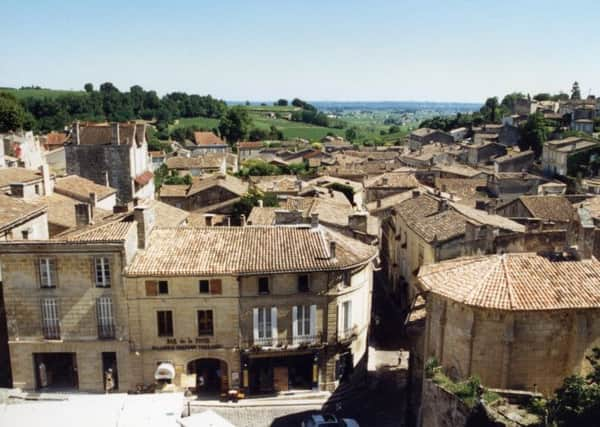Wine Club: In a league of their own


LAST weekend a long procession of red-robed members of the Jurade of St Emilion wound their way through the cobbled streets of this historic Bordeaux wine town to proclaim the official start of the 2014 harvest.
It is a day-long celebration, incorporating the procession, a church service, a ceremony to welcome new members and a grand lunch with significant quantities of wine. The day culminates in the harvest declaration from the top of the tower in the town centre. The whole occasion acts as a reminder of the ancient rights and laws of the region as well as providing a fabulous spectacle for tourists.
Advertisement
Hide AdAdvertisement
Hide AdAnd does it still mark the start of the harvest? Not really. These days the actual start is determined at each property by oenologists who analyse the sugars, tannins and flavours in the grapes.
But in the past, long before such techniques were available, the proclamation was the only way for the region to maintain its quality and reputation. By making sure that growers did not pick before the fruit was perfectly ripe, the Jurade was able to lay the foundation for its wine laws which were possibly the most draconian of any region in France. Before any wine could be sold it had to be tasted by the ruling council and if a barrel of wine was not deemed good enough to bear the name of the region it was smashed and the wine allowed to run out while the barrel was burnt.
The Jurade was established in 1199 by King John, youngest son of King Henry II of England and Eleanor of Aquitaine who ruled over England and the western part of France. By creating a local legislature he made the region easier to govern and, in turn, it remained loyal to his rather distant rule, making sure that England was supplied with huge quantities of wine each year. The modern Jurade, re-established in 1948, is not quite so powerful and much of its work is in promoting the region rather than smashing barrels but there is still an element of self-regulation since St Emilion is the only wine region of Bordeaux that re-issues its quality classification every 10 years.
Classification of any wine region is a handy way to pinpoint which properties are making the best wines. It started in 1855 when a group of wine brokers drew up a list of the best Médoc, Graves, Sauternes and Barsac wines – a structure which was meant to last just until the following year’s Paris Exhibition but which remains largely unchanged today. St Emilion was not included in this evaluation but a century later the Right Bank region of St Emilion issued its own classification with the intriguing concept that it is reviewed every ten years, which allows for properties to be promoted or demoted.
Advertisement
Hide AdAdvertisement
Hide AdWhilst this kind of continuous assessment has a distinct element of fairness about it, any system that can generate a league table of quality undoubtedly has its challenges. Each movement up or down can have a dramatic effect on the reputation of a property and the price of its wine. One can only imagine the wranglings that go on behind the scenes, and some reclassifications have been abandoned as open arguments have broken out.
The 2012 version of reclassification has largely been accepted with two new additions to the top set as Chateaux Angélus and Pavie join Ausone and Cheval Blanc in the Premiers Grands Crus Classés (A) with many changes further down the scale.
St Emilion has always been one of the more affordable and approachable regions for quality Bordeaux. Its Merlot-dominated blend gives a rich, lush, velvety style compared with the Left Bank’s more austere structured wines. It also has a lot more history behind it. The Romans settled here and grew grapes when the Médoc was still undrained land, and whilst the Médoc’s large estates are dominated by grand but mainly empty châteaux, in St Emilion the properties are smaller and usually lived in by their owners which makes it a friendly place to tour and visit.
The town itself is built from honey-coloured limestone quarried from the hill it sits on and there is even a church dug out from the rock underground, with only the spire conventionally built above ground.
Advertisement
Hide AdAdvertisement
Hide AdSurrounding this Unesco World Heritage town are 5,000 hectares of vineyards divided between over 800 properties in St Emilion, so learning their names and tastes is a life’s work of enjoyment. One of the best ways to gain an appreciation of the region is to attend the many tastings, lunches and even visits to the region organised by the Yorkshire branch of the Jurade. There is a lunch tomorrow at York’s Mansion House when several St Emilion wines will be poured. Check the website www.yorkfoodfestival.com or ring 01904 635149 to find out if there are still places left. If you are interested in attending other events then contact Tim Hartley ([email protected]) who is the York Chancellor of the Jurade de St Emilion. The trips that he organises to St Emilion are unparalleled in terms of opening doors and bottles that you simply cannot do on your own.
Acquiring a taste for the wines of St Emilion is easy. Most wine merchants have a small selection and Majestic is a good place to start. Domaine de Gaffelière 1996 (£14.99 on multi-buy) is a ripe and ready wine, with smooth tannins and a mature style. Trade up to Angelique de Monbousquet (£18 on multi-buy) from the terrific 2009 vintage for plumper black and red fruits with enough structure to cope with a roast lamb lunch. For a special occasion, push the boat out for a bottle of Ch Cauvin 2006 (£30 on multi-buy). More structured than many St Emilion wines it has deep, elegant complexity.